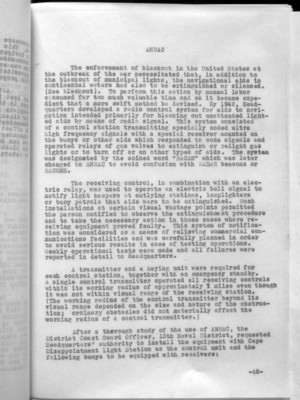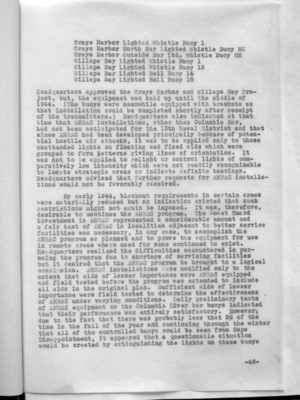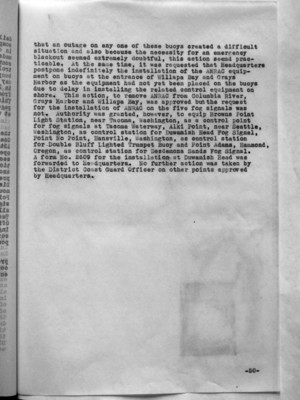Pages That Mention BLACKOUT
Coast Guard District narrative histories 1945
65
The enforcement of blackout in the United States at the outbreak of the war necessitated that, in addition to the blackout of municipal lights, the navigational aids in continental waters had also to be extinguished or silenced. (See blackout). To perform this action by manual labor consumed far too much valuable time and so it became expedient that a more swift method be devised. By 1942, Headquarters developed a radio control system for aids to navigation intended primarily for blacking out unattended lighted aids by means of radio signal. This system consisted of a control station transmitting specially coded ultra high frequency signals with a special receiver mounted on the buoys or other aids which responded to code signals and operated relays of gas valves to extinguish or relight gas lights or to turn off or on other types of aids. The system was designated by the coined word "RACAN" which was later changed to ANRAC to avoid confusion with RADAR beacons or RACONS.
The receiving control, in combination with an electric relay, was used to operate an electric bell signal to notify light keepers at outlying stations, lamplighters or buoy patrols that aids were to be extinguished. Such installations at certain visual vantage points permitted the person notified to observe the extinguishment procedure and to take the necessary action in those cases where receiving equipment proved faulty. This system of notification was considered as a means of relieving commercial communications facilities and was carefully planned in order to avoid serious results in case of testing operations. Weekly operational tests were made and all failures were reported in detail to Headquarters.
A transmitter and a keying unit were required for each control station, together with an emergency standby. A single control transmitter operated all receiving controls within its working radius of approximately 7 miles even though it was not within visual range of the receiving station. (The working radius of the control transmitter beyond its visual range depended on the size and nature of the obstruction; ordinary obstacles did not materially affect the working radius of a control transmitter.)
After a thorough study of the use of ANRAC, the District Coast Guard Officer, 13th Naval District, requested Headquarters' authority to install the equipment with Cape Disappointment Light Station as the control unit and the following buoys to be equipped with receivers:
-45-
68
Grays Harbor Lighted Whistle Buoy 1 Grays Harbor North Bar Lighted Whistle Buoy NC Grays Harbor Outside Bar Ltd. Whistle Buoy GH Willapa Bay Lighted Whistle Buoy 1 WIllapa Bay Lighted Whistle Buoy 12 Willapa Bay Lighted Bell Buoy 14 Willapa Bay Lighted Bell Buoy 18
Headquarters approved the Grays Harbor and Willapa Bay Project, but, the equipment was held up until the middle of 1944. (The buoys were meanwhile equipped with brackets so that installation could be completed shortly after receipt of the transmitters.) Headquarters also indicated at that time that ANRAC installations, other than Columbia Bar, had not been anticipated for the 13th Naval District and that since ANRAC had been developed principally because of potential hostile air attacks, it was to be applied only to those unattended lights on floating and fixed aids which were grouped to form patterns giving lines of orientation. It was not to be applied to relight or control lights of comparatively low intensity which were not readily recognizable to locate strategic areas or indicate definite bearings. Headquarters advised that further requests for ANRAC installations would not be favorably received.
By early 1944, blackout requirements in certain areas were materially reduced but no indication existed that such restrictions might not again be imposed. It was, therefore, desirable to continue the ANRAC program. The Coast Guard investment in ANRAC represented a considerable amount and a fair test of ANRAC in localities adjacent to better service facilities was necessary, in any case, to accomplish the ANRAC program as planned and to prove the equipment for use in remote areas where need for same continued to exist. Headquarters realized the difficulties encountered in pursuing the program due to shortage of servicing facilities but it desired that the ANRAC program be brought to a logical conclusion. ANRAC installations were modified only to the extent that aids of lesser importance were ANRAC equipped and field tested before the program was extended to include all aids in the original plan. Sufficient aids of lesser importance were field tested to determine the effectiveness of ANRAC under varying conditions. Daily preliminary tests of ANRAC equipment on the Columbia River bar buoys indicated that their performance was entirely satisfactory. However, due to the fact that there was probably less that 5% of the time in the fall of the year and continuing through the winter that all of the controlled buoys could be seen from Cape Disappointment, it appeared that a questionable situation would be created by extinguishing the lights on these buoys
-48-
70
that an outage on any one of these buoys created a difficult situation and also because the necessity for an emergency blackout seemed extremely doubtful, this action seemed practicable. At the same time, it was requested that Headquarters postpone indefinitely the installation of the ANRAC equipment on buoys at the entrance of Willapa Bay and Grays Harbor as the equipment had not yet been placed on the buoys due to delay in installing the related control equipment on shore. This action, to remove ANRAC from Columbia River, Grays Harbor and Willapa Bay, was approved but the request for the installation of ANRAC on the five fog signals was not. Authority was granted, however, to equip Browns Point Light Station, newar Tacoma, Washington, as a control point for fog signals at Tacoma Waterway, Alki Point, near Seattle, Washington, as control station for Duwamish Head Fog Signal, Point No Point, Hansville, Washington, as control station for Double Bluff Lighted Trumpet Buoy and Point Adams, Hammond, Oregon, as control station for Desdemona Sands Fog Signal. A form No. 2609 for the installation at Duwamish Head was forwarded to Headquarters. No further action was taken by the District Coast Guard Officer on other points approved by Headquarters.
-50-


